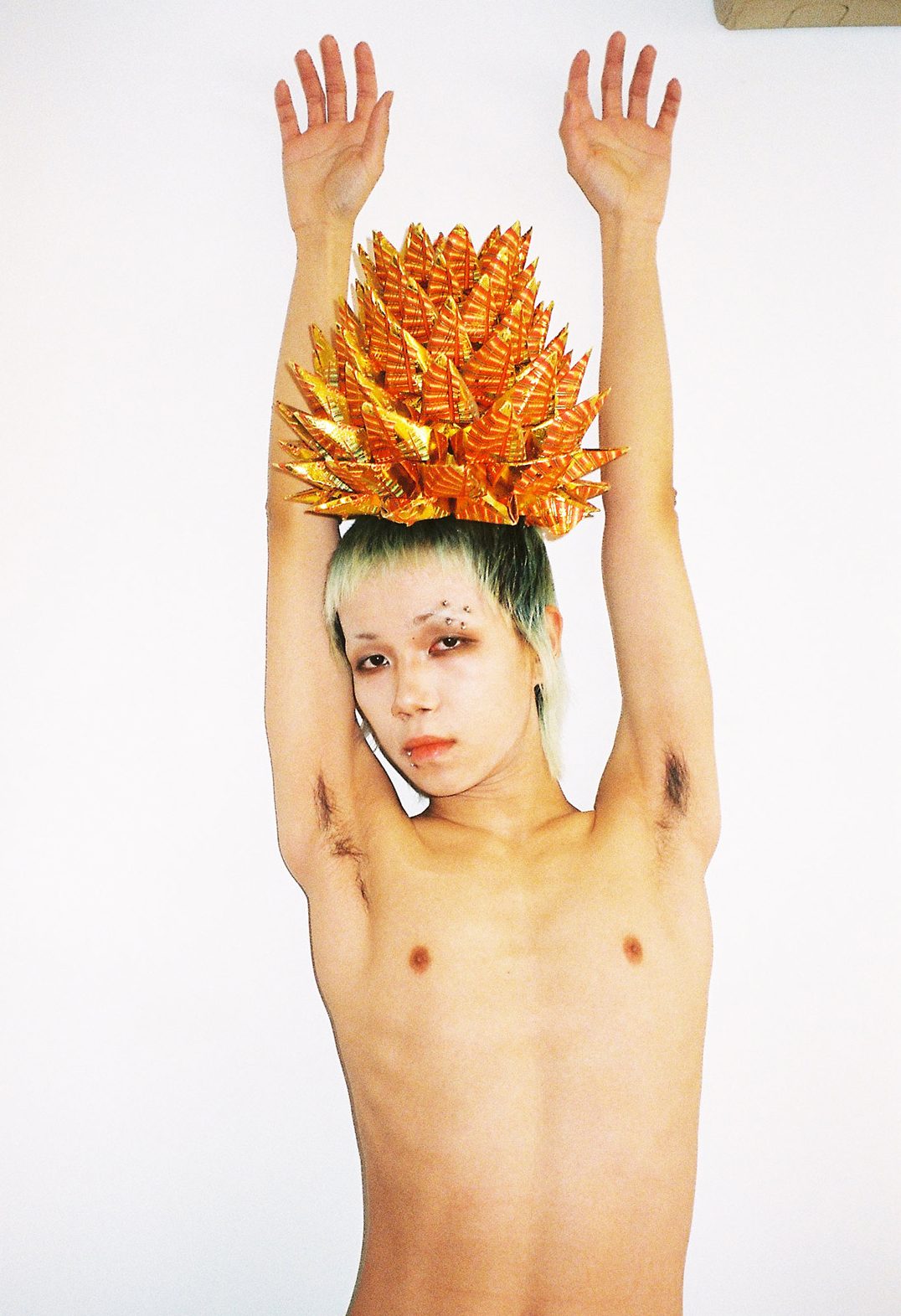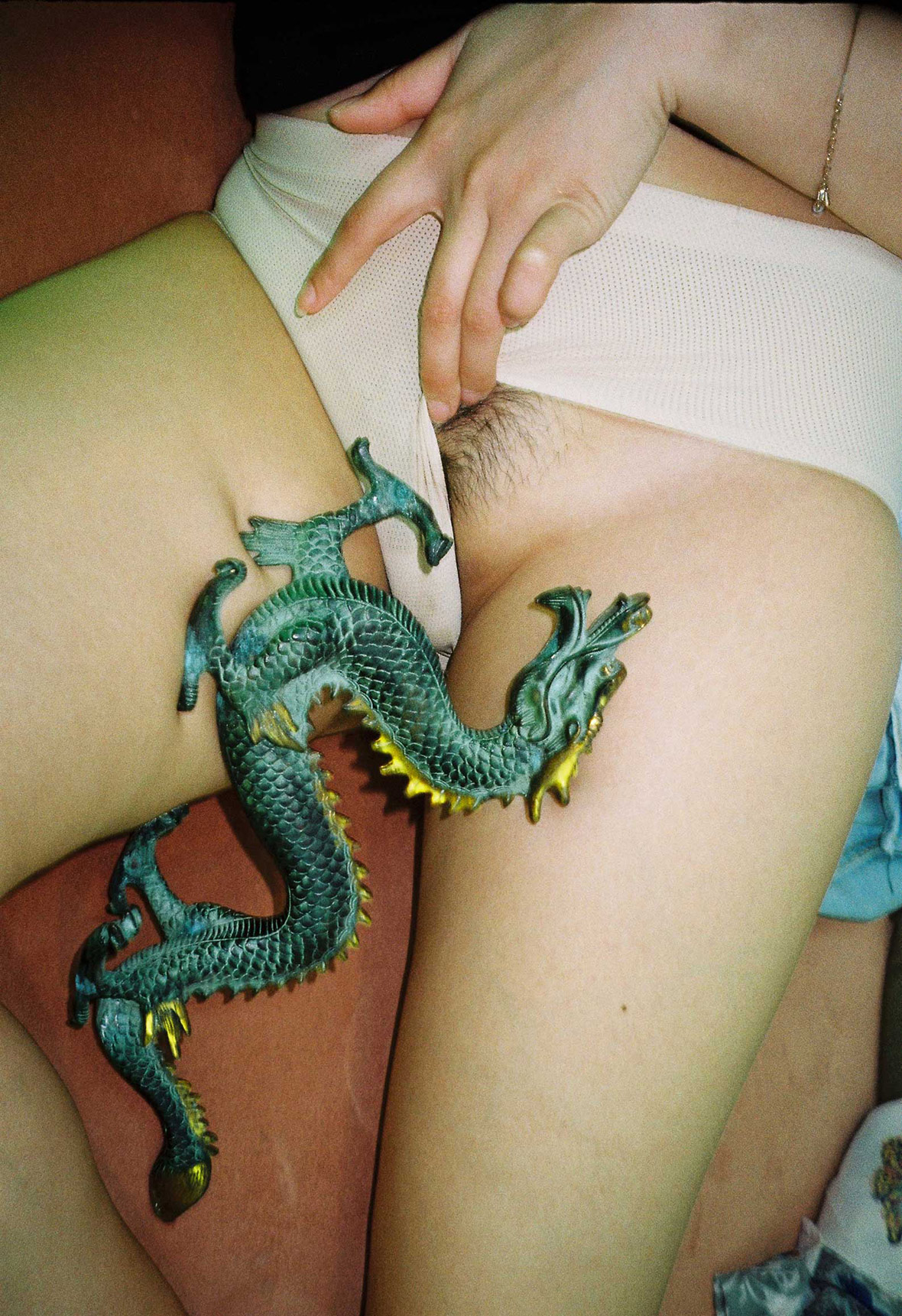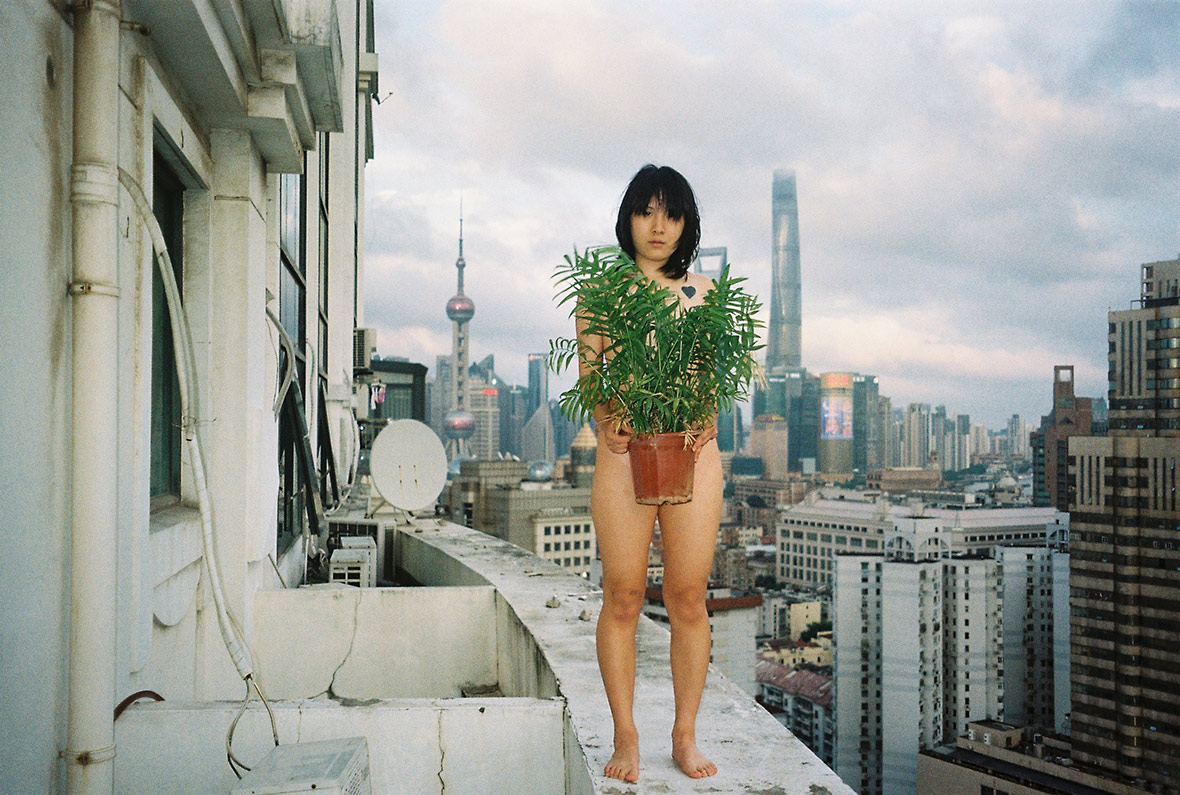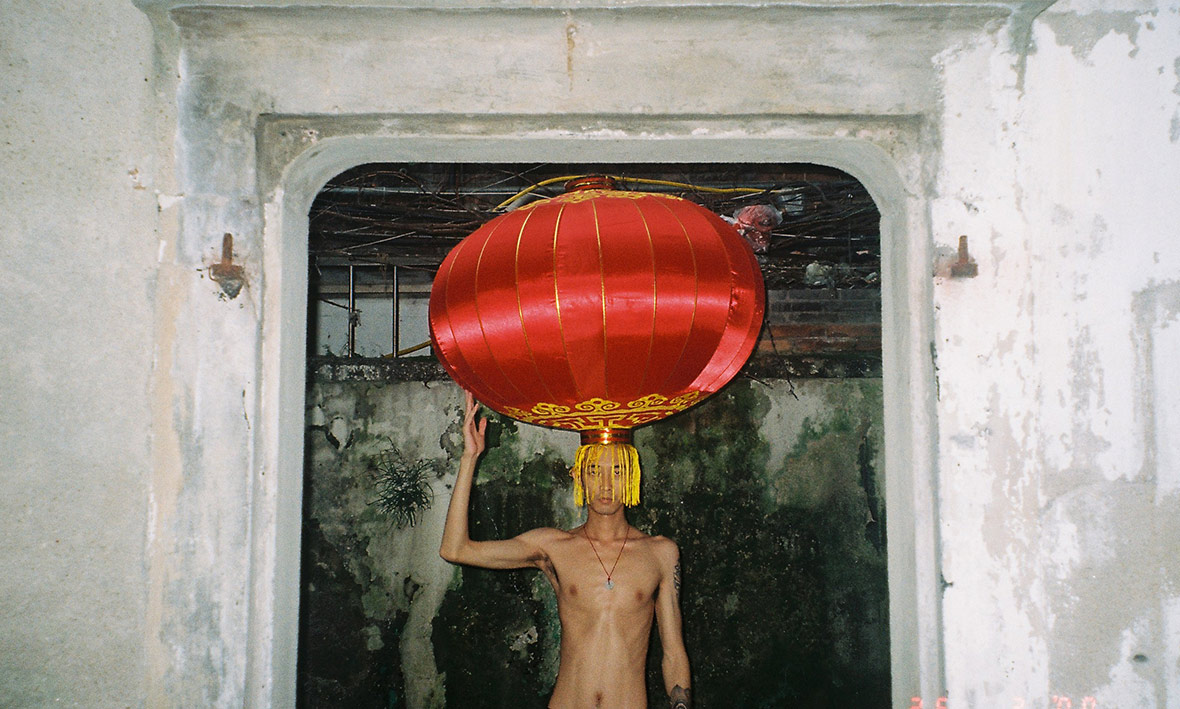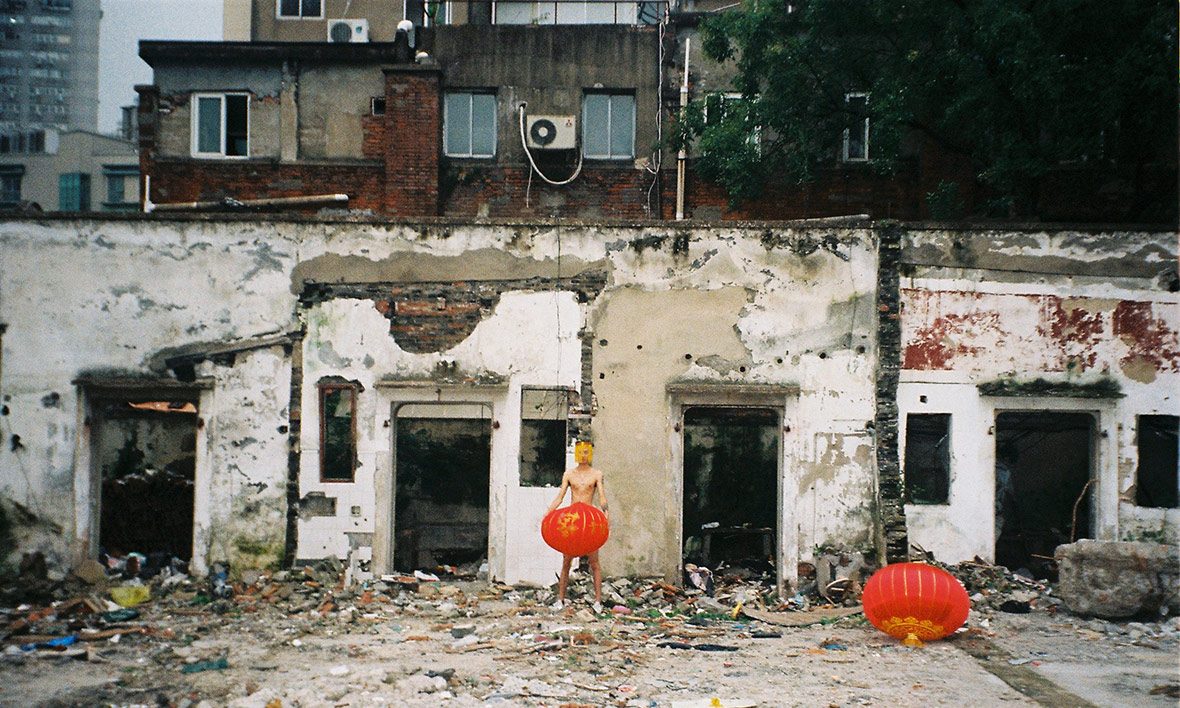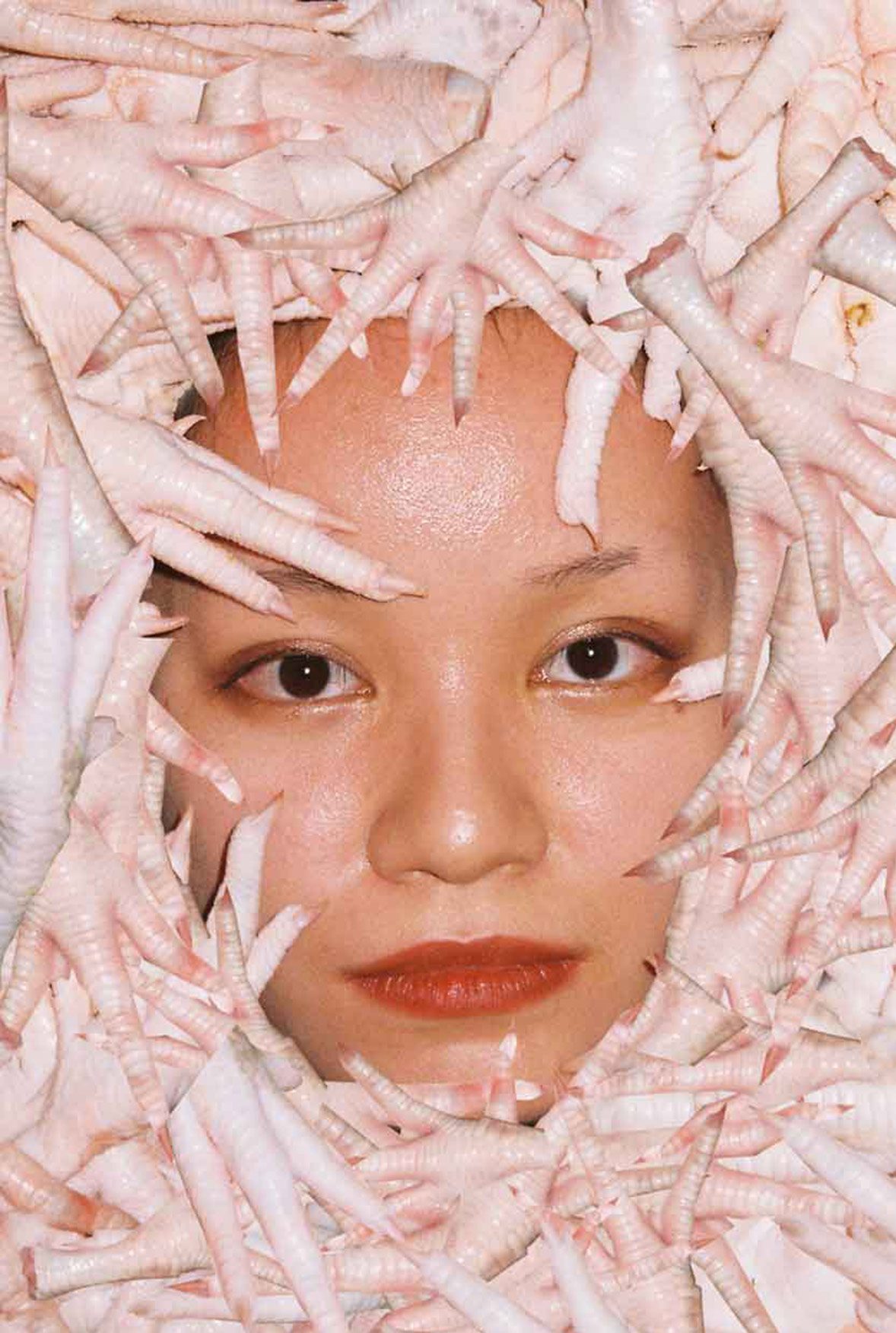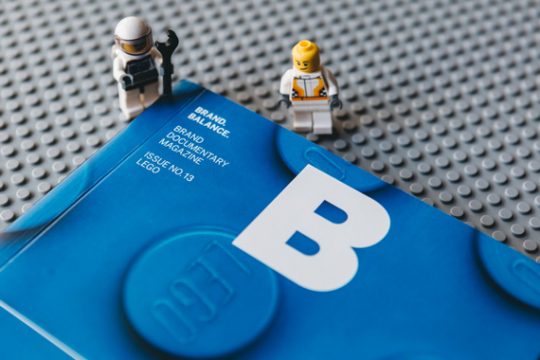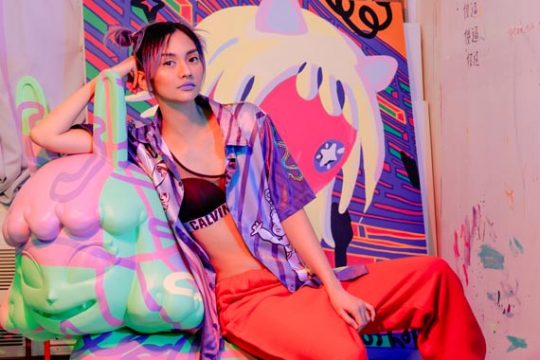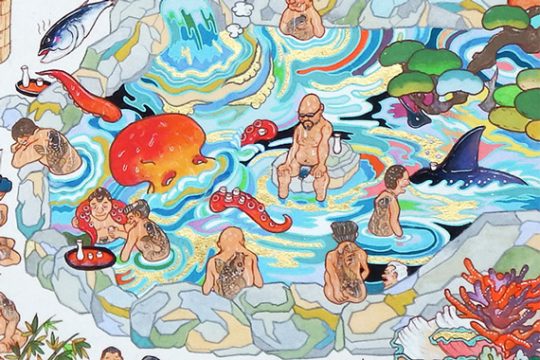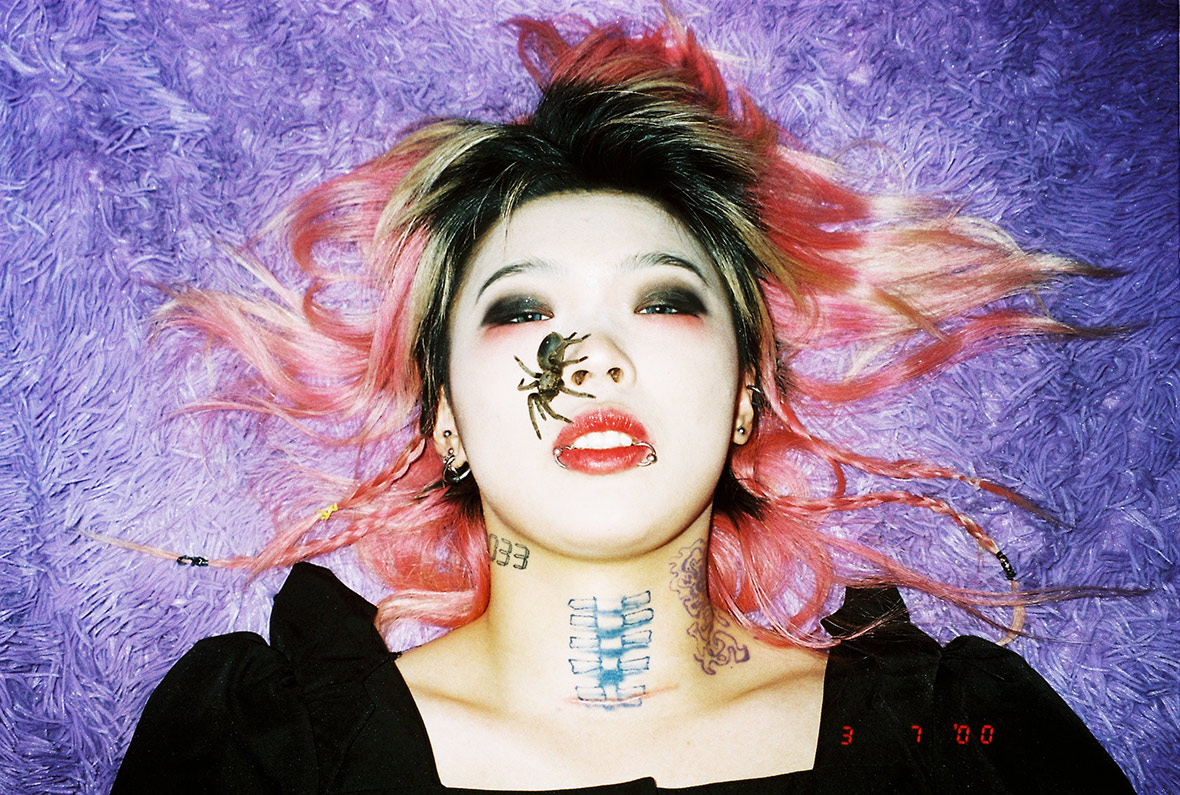
“I’m not a photographer, and I don’t want to become one,” says Lao Xie Xie with a laugh. “I just use a camera as a tool to make real what I have in my mind.” If that’s true, then his mind is a sublime and seamy place. The bare-skinned models and butcher-shop scraps, cropped to look like something out of a 90s punk zine, feel calculated to shock. No wonder he often labels his work with the hashtag #trashphotography.
“我不是摄影师,我也不想成为摄影师。”Lao Xie Xie 笑着说,“相机只是我的一个工具,用来表达我内心的想法。”如果真是这样,那么他的内心会是一片即神圣又晦涩的境地。赤裸的模特和肉店边角料的拼贴,看起来就像是 90 年代的朋克杂志,带来深思熟虑后的视觉冲击,难怪他喜欢用 “#垃圾相册” 来为自己的作品贴上标签。
Lao Xie Xie—the pseudonym means something like “Mr. Thank You”—didn’t start taking pictures until 2019, when a friend gave him a used Olympus Zoom 105, a film camera from the eighties that still stamps every image with the date in boxy orange numbers. The analog equipment lends his work an unpolished look, like snapshots caught on the fly. Yet most of his photos are at least partly planned. “Usually I have something in my mind that I know can work, a sort of preview in my brain,” he explains. The rest springs organically from the setting. “When I shoot, I go freestyle, using what I find at the location, and my connection to the model.”
Lao Xie Xie 这个佚名意为 “谢谢先生”,他从 2019 年开始摄影,起因是一位朋友赠送的一部二手 Olympus Zoom 105 相机。这部 80 年代的胶卷相机会在照片上标记橘黄色的数字日期,拍出来的作品往往带有一种粗糙、即兴的质感,就像是在运动中定格的快照一样。但事实上,他的大多数照片多多少少都经过精心设计。他解释道:“我一般会先确定好想拍的效果,在脑海里有一个预览。”之后,就看现场的自由发挥,“拍摄的时候,我喜欢搜寻场地内可利用的道具,带着我跟模特之间的默契,进行即兴创作。”
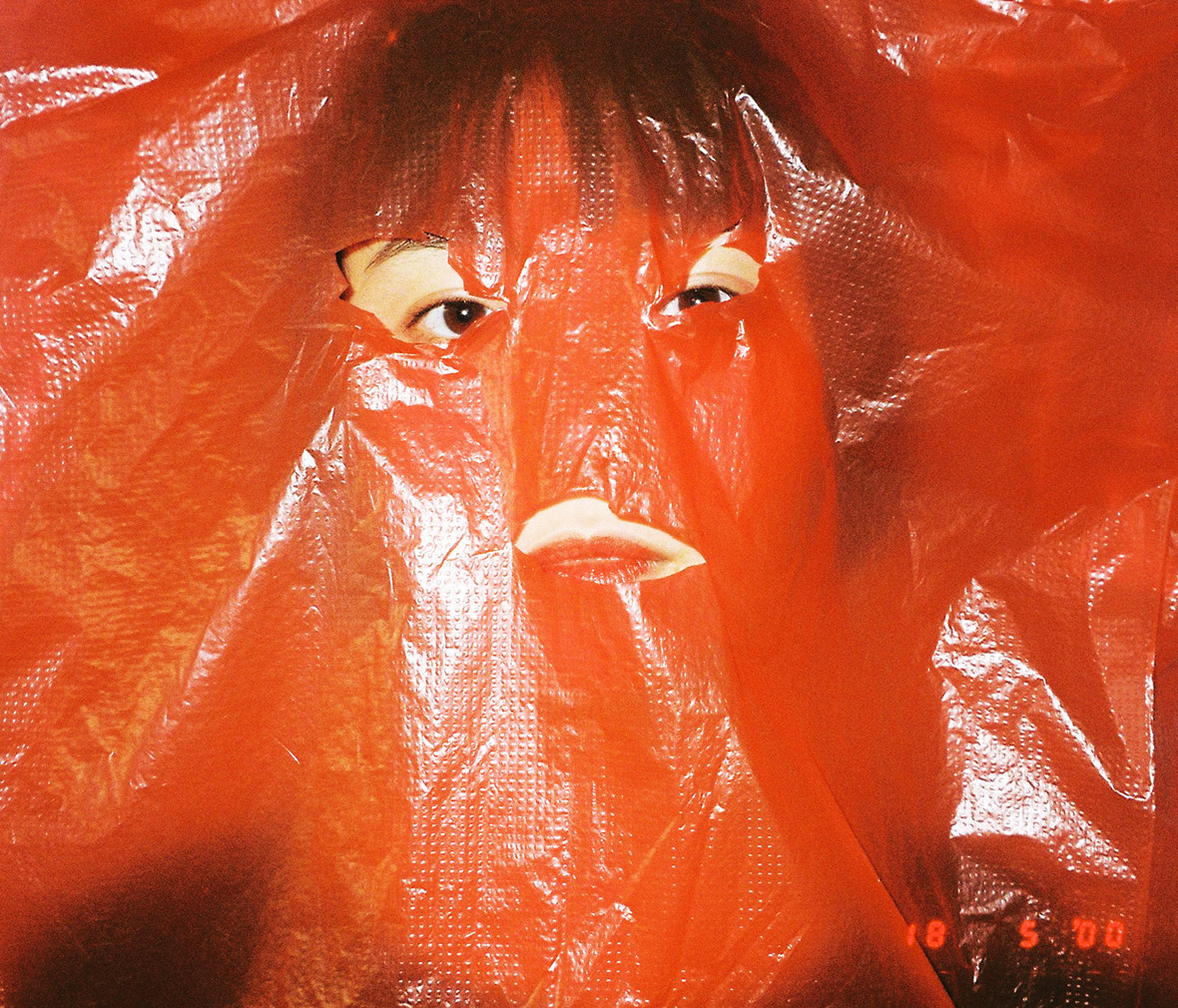
A case in point is the photograph of a woman crouched in front of a pile of discarded Ofo bicycles. She wears a glossy chartreuse gown with a matching hairband and looks straight at the camera with a skeptical expression. Hand on the seat, body leaning slightly forward, she exudes a dynamism that sets her apart from the static background of stacked bicycles. There’s nothing casual about the shot: she’s not dressed for a ride, and the bicycles are out of commission. Rather, it’s a deliberate study in form and color whose strength lies in its lines of tension and echoing yellows and greens.
譬如在一幅女模特靠在一堆废弃 Ofo 共享单车前的照片当中。女人身穿鲜亮的淡绿色长裙,搭配相同颜色发带,一脸狐疑地直视镜头。她的手放在车座上,身体略微前倾,流露出一种活力,与背景中堆叠在一起的单车形成对比。这种对比也并非偶然:她的着装绝非骑行所用,而显然这些单车也已经报废。这种有意安排的形式和颜色,通过线条对比的张力、黄色与绿色的呼应呈现。
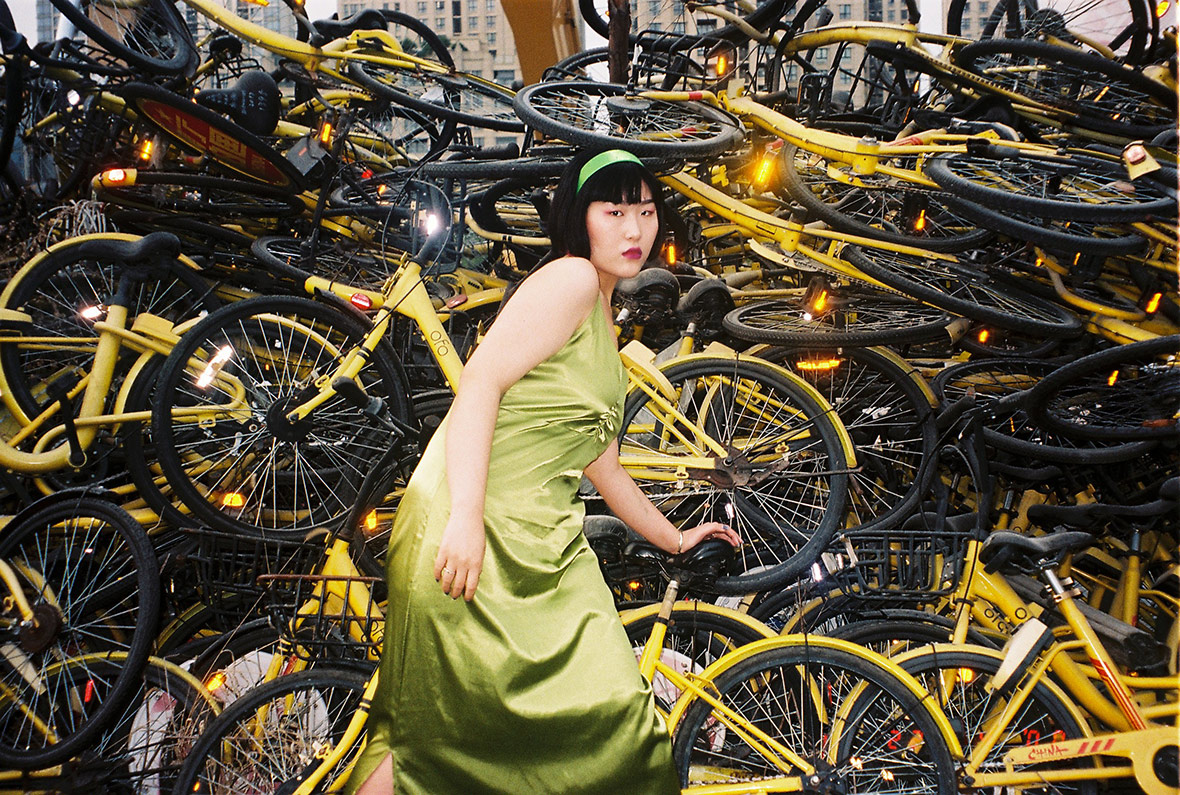

Lao Xie Xie didn’t always plan out his compositions. “In the beginning, when I started to take pictures, I wasn’t happy with some of my shots, so I started photoshopping them and making collages,” he explains. He still uses collage to create effects that would otherwise be impossible, such as pasting a man’s facial features on his chest. Mostly, though, he’s shifted his attention to the advance preparation. “Now I try to focus more during the shoot. I don’t do as much post-production, just some color correction.” In one photo, a shirtless man wearing a giant Chinese lantern on his head stands in a small room strewn with trash. It’s another odd, visually compelling contrast, and the effect arises entirely from the composition, not the editing.
Lao Xie Xie 也是在最近才开始计划性的拍摄。他说:“刚开始拍照片时,拍的一些照片我自己不太满意,就开始后期修图,制成拼贴画。”他现在还是会通过拼贴来呈现一些照片所无法达到的效果,例如将一个人的面贴到他的胸部。不过,Lao Xie Xie 目前更关注照片的构图方式。他说:“现在,我会尽可能关注拍摄的过程。而不会再做过多的后期,顶多调色而已。”在他的一张照片中,一个光着膀子的男人头顶硕大的中国灯笼,站在满布垃圾的小房子前,形成另一种古怪但夺人眼球的对比。整张照片的效果完全来自构图,而不是后期编辑。
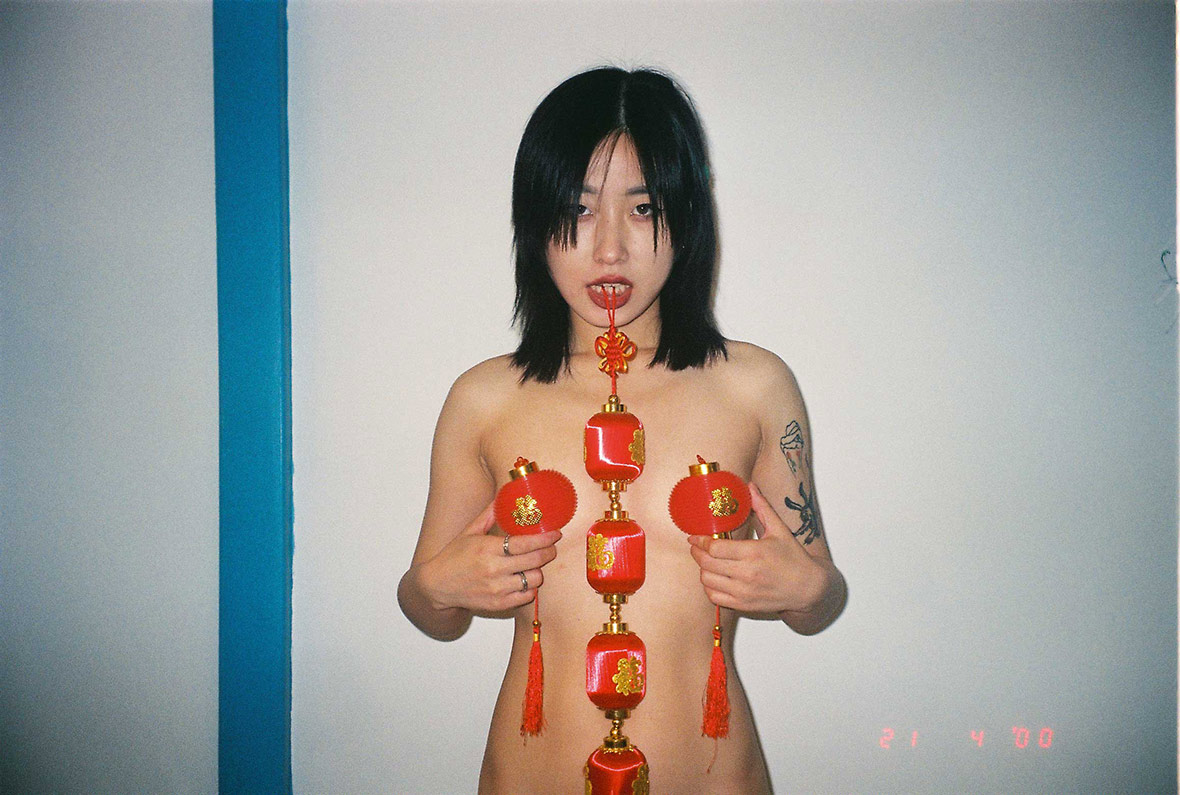
Red lanterns and stacks of discarded bicycles point to another key aspect of Lao Xie Xie’s photography: his use of conspicuously Chinese elements. “There’s a strong aesthetic in China that’s totally different from other countries,” he says. “I like to play with these elements because I think they’re very beautiful, and people outside don’t know about them.” Of course, dragons or New Year’s decorations are familiar enough even in the West, yet other elements, like chicken’s feet or pig’s trotters—two traditional delicacies that foreigners don’t always appreciate—are indeed unfamiliar outside China. Lao Xie Xie uses them in a playful spirit, for example by framing a model’s face in claws. He highlights their raw, campy beauty, and shows how such markers of Chinese-ness aren’t inherently traditional or conservative, but can also be part of a “trash” aesthetics of urban street culture. His interest in these elements may have something to do with his own outsider status: despite claiming in an interview to have grown up in a poor village in Sichuan, he’s not Chinese but European.
“红色灯笼” 和 “成堆的废弃单车” 点出了 Lao Xie Xie 的摄影作品中的主打色调 —— 中国元素。他说:“中国有一种区别于其他国家的强大审美。我喜欢用这些元素创作,一方面是好看,另一方面,这些都是其他国家比较陌生的事物。”当然,西方国家对 “龙” 或 “新年装饰” 这些元素都已经十分熟悉,但依然还有很多他们不了解的中国元素,例如 “鸡脚” 或 “猪蹄”,这是两种传统的中国美食,但许多外国人都不知道,或避而远之。Lao Xie Xie 喜欢以一种玩乐的精神来呈现这些元素,例如用鸡爪沿模特的脸部轮廓堆叠。他在作品中突显着这些元素原始的、浮夸的美,向人们展示这些中国元素绝不只有传统或保守的一面:它们也可以成为另一种城市街头文化的 “trash” 美学。他对这些元素的兴趣可能与他的局外人身份有关:尽管在一次采访中,他声称自己在四川某个贫穷的村庄长大,但他其实不是中国人,而是欧洲人。
Lao Xie Xie seems focused on honing his style and exploring a repertoire of subject matter. Maybe one day he’ll embrace the title of photographer—after all, the medium seems to suit him. Maybe one day he’ll even admit that he’s not Chinese. What’s clear for now is that this newcomer has an eye for the unusual and an irresistibly sordid imagination.
现在,Lao Xie Xie 正专注于打磨自己的风格,尝试探索各种题材。也许有一天他会欣然接受摄影师这个头衔——毕竟,这些创作媒介和他自身的文化背景也很相符。但毋庸置疑的是,这位摄影新秀有着相当独特的视角以及令人难以抗拒的粗劣臆想。
Like our stories? Follow us on Facebook and Instagram.
Instagram: @lao_xie_xie
Contributor: Allen Young
Chinese Translation: Olivia Li

